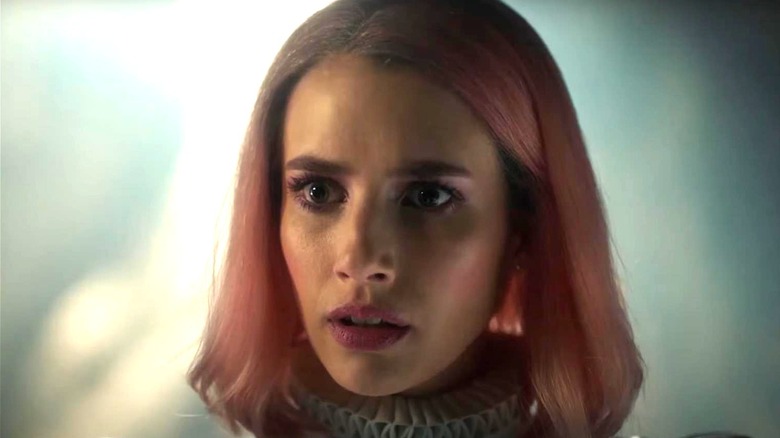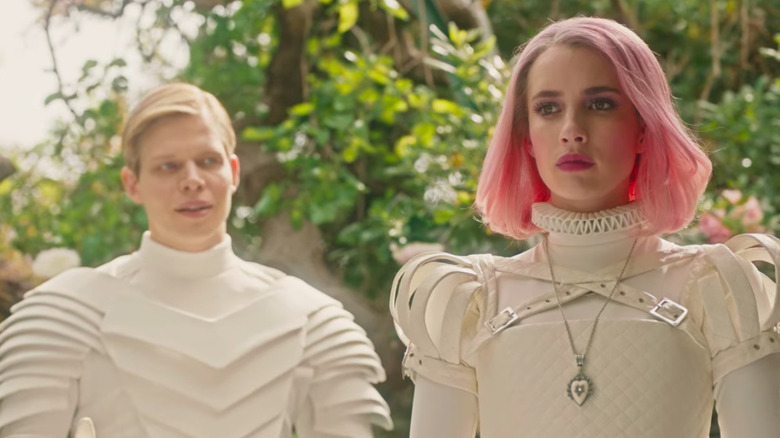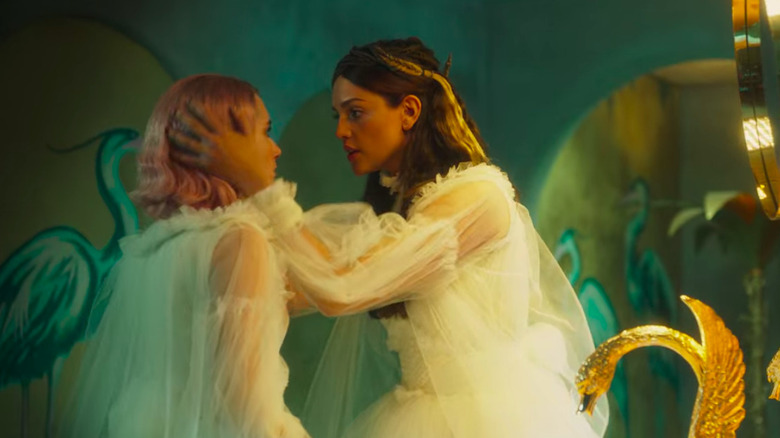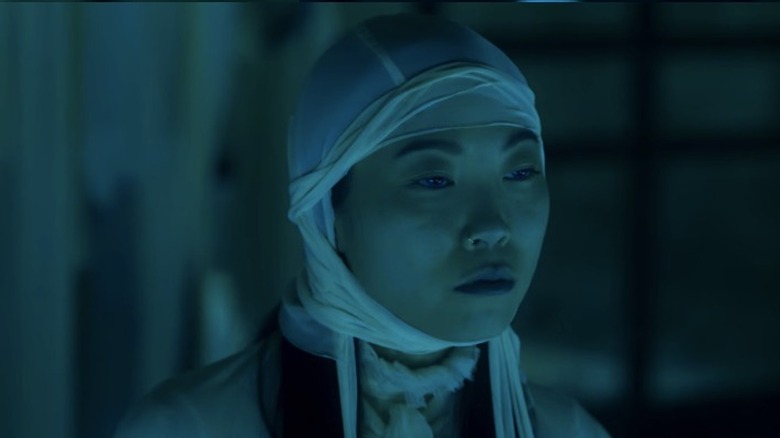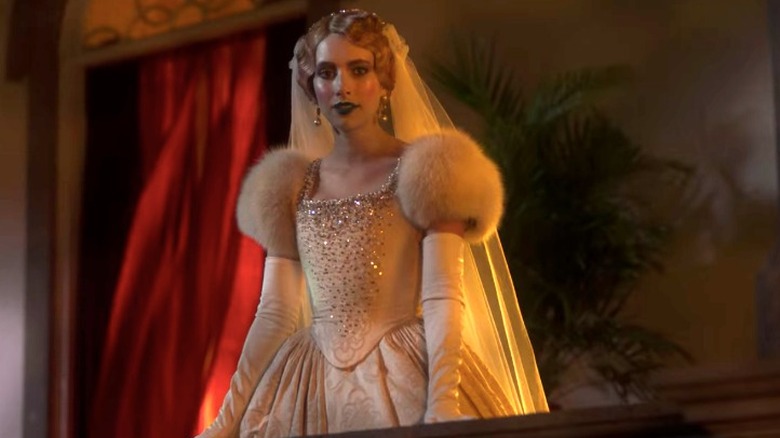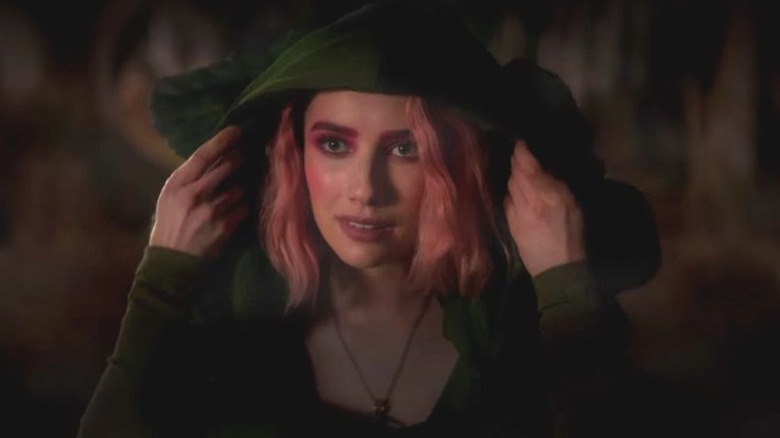The Ending Of Paradise Hills Explained
In her feature film directorial debut, "Paradise Hills," Alice Waddington constructs a simultaneously ornate and seductive yet deeply unsettling futuristic world in which anachronisms in attitudes, dress, and social hierarchy act as a form of toxic nostalgia — and a means by which the upper classes and the patriarchy maintain control. Based on an original story by co-writer Sofía Cuenca, the film boasts an all-star cast, including "Scream Queens" and "American Horror Story" veteran Emma Roberts, actor, rapper, and writer Awkwafina, supermodel, designer, and actor Milla Jovovich, "Unbelievable," "Dumplin," and "Bird Box" star Danielle Macdonald, and Eiza González of "I Care a Lot." Set in an intentionally vague future wherein people are referred to as "Uppers" and "Lowers," cars finally fly, and the economic gap appears to resemble that of pre-to-early industrial age London, the core narrative of "Paradise Hills" has been likened to a feminist version of Kubrick's "A Clockwork Orange" (via Pajiba). Its mood and landscape have been compared to "Picnic at Hanging Rock," and its often been viewed alongside narratives such as "The Handmaid's Tale" and "Suspiria" (via RogerEbert).
On the surface, these comparisons make sense. The narrative occurs in a "therapeutic rehab" school-like setting (like "Suspiria") that ostensibly brainwashes (like "A Clockwork Orange") young women into becoming more compliant and "ladylike." There's a rigid gender and class hierarchy (like "The Handmaid's Tale") and the haunting and soothing, dream-like coastal geography does indeed resemble "Picnic at Hanging Rock." However, by the end of Waddington's impressionistically painted mash-up of various feminist and control vs. freedom allegories and narratives, "Paradise Hills" proves it has something more specific to say about how and why such an apocalyptic paradise might come to be. Moreover, its a statement the film makes no secret of building toward throughout.
The costumes in Paradise Hills mean more than they appear
The costumes in "Paradise Hills" aren't just there to leave a striking visual impression (though they certainly do) or inspire this year's most niche Halloween get-ups (which they undoubtedly will, now that it's moved to Netflix). The blend of twelfth and thirteenth century chivalrous call-backs (the corsetry and Juliet sleeves, the attendants dressed as literal white knights), and touches of Edwardian and Antebellum South silhouettes, fabrics, and color palates — as well as the various nods to the 1960's revival of such concepts — all have something to say about the evolution of patriarchal control.
It's no accident the young women at Paradise Hills are referred to as "Mademoiselles." As fairytale-like as the French literary and military invention of chivalry might appear in everything from Arthurian literature to Disney movies, it belies a mythology about the roles and "definitions" of men and women that helped justify the oppression of the latter — one of Waddington's focal points — right up until the 21st century. The idea that women are delicate damsels in distress in need of both rescue and protection from men is a notion that helped (for example) the U.S. Government justify a litany of sexist and oppressive patriarchal legislation. It's a notion that 1970s Equal Rights Amendment opponent Phyllis Schafly fell back on, again and again, to support her argument that if women were granted equality, they'd lose the natural protections that being "take care of" by their husbands afforded them (via TIME).
Paradise Hills uses its aesthetic to reiterate its subtext
In dressing both the patients and operators of Paradise Hills in garb from grossly romanticized eras in history that most reinforce this antiquated understanding of both gender and gender roles (as well as eras that prioritize both whiteness and heterosexuality), Waddington is hinting at one of the most important theses in her film. That is, that the combination of blind nostalgia and false history, a too-narrow understanding of "a successful society," and a total lack of empathy, is a near perfect recipe for a dystopian world built on injustice, inequality, oppression, and a deadly acceptance of extreme prejudices and othering.
In addition to dressing her main characters in attire that glorifies these eras as well as their understandings of womanhood, Waddington takes things a step further. The patients of "Pardise Hills" are dressed, always, in monochromatic, white dresses and dressing gowns. The association of white with "virginal purity" — and the dystopian future's belief that this, too, is a necessary characteristic of the ideal woman — reiterates this future world's unworkably narrow definition of womanhood. On the one hand, these Uppers are expected to be sexually appealing, charming, and charismatic. On the other, they're expected to be chaste, and to hand over their sexuality to the men in power.
Paradise Hills is critical of a certain kind of 'feminism'
Though viewers aren't given an explicit timeline or explanation of the events leading up to the baroque "Brave New World" in which the narrative is set, the patients of "Paradise Hills" are all from the wealthy 1% who came out on top following a series of alluded-to wars (aka, the Uppers). Emma Roberts' Uma is sent there when she refuses to marry the sadistic businessman responsible for her father's bankruptcy and suicide. Danielle Macdonald's Chloe is sent there because her wealthy family wants her skinnier. Eiza González' Amarna (a mega pop star) is sent there when her record company and family decide she's become too difficult to market — ostensibly because she wants to sing "in her own voice," but more likely because she's a lesbian. And although Awkwafina's Yu was born to the Lowers, she is sent to Paradise Hills to treat her social anxiety, which keeps her from fitting in with her wealthy aunt and uncle, and thus becoming a true Upper.
Waddington's focus on the sexist oppression of upper-class women isn't an accident or an oversight, but an element integral to what the film ultimately has to say about the dangers of feminism or resistance born from too-narrow a scope. When the women discover that the treatment center has no intentions of treating them, but is, instead, taking women from the Lowers and surgically recreating them in Uma's, Yu's, and Chloe's images as "substitutes" to send back in their stead, the film reveals itself to be doing something more than what it first appears.
Paradise Hills doesn't end on a high note
For the better part of the narrative, viewers are rooting for the heartbroken and fatherless (yet nonetheless privileged) Uma to lead her roommates to freedom. But when Uma confronts the still-mummified Lowers who are meant to replace her and her roommates — and shares the tragic story of her father's death and the position she's been put in — Yu's (importantly, now very blue-eyed) substitute responds by saying, "Do you believe you're the only one with a story like that? You know, we have families, too." The scene and the exchange are not just a wake-up call for Uma, but for the viewer as well.
Uma appears to realize that her own oppression — when viewed through the eyes of women whose experiences involve scrounging for food, living in squalor, and agreeing to undergo painful operations all in the hopes of a better life — actually looks like a kind of freedom. But if viewers were hoping that Uma's eventual team-up and escape from Paradise Hills with her Lower substitute (Anna, also Emma Roberts) would lead to an equally happy ending for both, Waddington's finale was bound to disappoint. Although Uma and Anna succeed in secretly killing the former's sociopath of a fiancé (Son, played by Arnaud Valois), and although the two switch places à la the (princess) and the pauper so that Anna will get to live Uma's privileged existence without the burden of Son, it's an ending that only reiterates Waddington's point.
Paradise Hills is both a warning and a reminder
Anna may have wealth now, but she's merely traded in her poverty and struggle to survive for a different sort of oppression and struggle. She'll still be largely controlled by both her wealthy mother and a class of people with an extraordinarily narrow definition of what it means to be a woman. Meanwhile, Uma gets to feel "good" about handing her privileged life over to one of the Lowers, and escapes off into the woods in an intentionally decadent, emerald green robe and dress. Ultimately, it is only the thin, privileged white woman who fully escapes her shackles and obtains true freedom. It is also Uma, not Anna, who gets to enjoy the privilege of taking back her power by killing Son.
Again and again, Waddington's film tells viewers (in particular, with its continued references to roses having thorns) that there's a dangerous trade-off involved in living the high life as a woman. "I had to become somebody else, so I could survive," Anna tells Uma. For the Lowers of Waddington's universe, this is both an emotional and a literal, surgical transition. For the Uppers, it's a transition that requires them to deny their instincts and identity in favor of becoming docile, protected (read: controlled), "perfect women."
While "Paradise Hills" stops short of depicting one kind of oppression as being "worse" than the other, its ending is a reminder that the securing of freedom for one class at the cost of (and further subjugation and abuse of) another isn't feminism, but oppression and injustice in a fancier dress.
